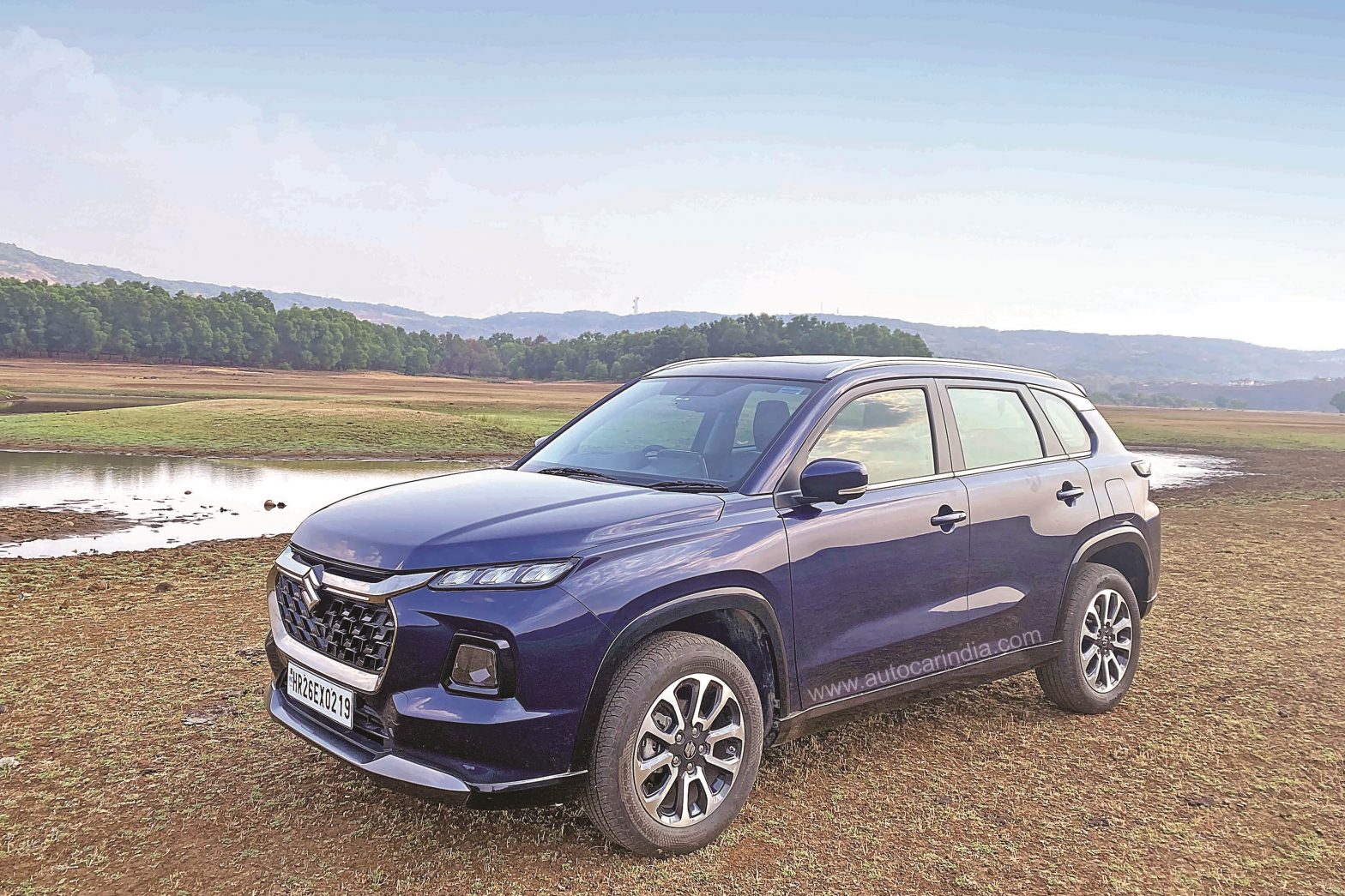It was baptism by fire for Hisashi Takeuchi when he took over as the MD and CEO of Maruti Suzuki India in April 2022.
The company was sitting on its lowest market share in close to a decade and its SUV segment share had slipped to single digits. Rivals riding on the SUV wave were gaining on the market leader.
The largest car maker was also going through significant business transition. Having bid adieu to its iconic Maruti 800 and Omni by 2019, followed by the Alto 800, the mass market champion abruptly exited the diesel segment in March 2020, which accounted for almost half a million units of Maruti Suzuki’s sales.
Takeuchi also had the tough task of bridging that diesel gap with CNG and hybrid powertrains, as a new, cleaner BS-VI emission norms-compliant portfolio was being rolled out systematically in the marketplace. It was a carefully thought-through process.
While the company was readying a new portfolio of SUVs – having missed out on the early action – multiple waves of Covid-19 had completely disrupted the launch plans.
When Takeuchi, a Suzuki veteran of over three and half decades, moved to India in April 2021, the second Covid-19 wave was wreaking havoc across the country. He had been observing the Indian market and the first Covid-19 wave’s disruption from his home in Japan.
Takeuchi had the help of an able ally, Kenichi Ayukawa, the outgoing MD, for over a year to ensure smooth transition. Ayukawa, after a successful stint in India, was being elevated to play a critical role at the headquarters.
The Indian market was not new for Takeuchi. He was first inducted onto the Board of Maruti Suzuki in 2019 and was made the Joint MD of commercial operations in 2021.
As he was taking over the India operations, the domestic car market was seeing a bounce back; social distancing and lockdowns of Covid-19 was making personal mobility more of a necessity than an aspiration. Takeuchi had enough in his arsenal to go on the offensive.
Action-packed 18 months
While homegrown rivals Tata Motors and Mahindra & Mahindra were rapidly winning bigger shares in the SUV space in 2022 and newbies like Kia had already cornered a sizable market, Maruti was yet to see the full impact of its new range of SUVs due to shortage of semiconductor chips. To make matters worse, its bread and butter, the small-car segment, was hitting new lows.
If 2022 was about putting the wheels in motion, 2023 was about stepping on the accelerator for Takeuchi. He had one eye on seizing back the lost market share and the other on defining a long-term vision for the company in partnership with the headquarters.
Earlier this year, Maruti Suzuki announced Vision 3.0 – by far the most audacious mid-term goal set by the company. The plan envisages Maruti Suzuki to double production capacity and revenues in eight years; triple exports from India and expand product portfolio to 28 models from 17 at present, with a whopping investment of Rs 1.25 lakh crore. Takeuchi was the most important architect of this road map.
To underscore the magnitude of the task in hand, it took Maruti Suzuki four decades to reach two million units of annual production. Now it wants to create an incremental two million units in just one-fifth that time. Not only is it aspiring to grow its volumes, but it aims to do that with a lower stress on the environment with over half a dozen zero emission alternatives in the mix.
Shifting gears
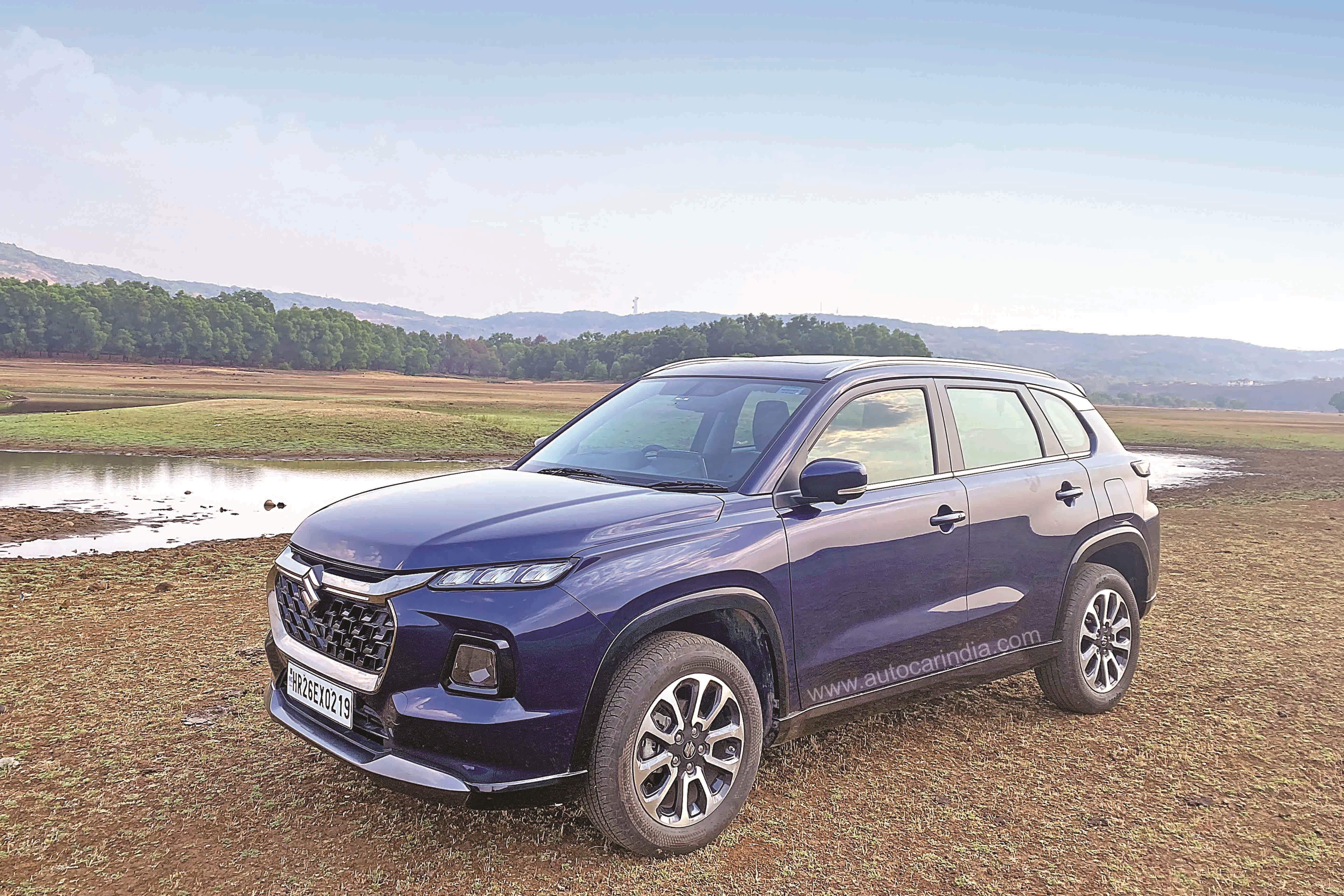 Unveiling a range of SUVs at the Auto Expo 2023, Takeuchi had declared that Maruti Suzuki will gun for SUV leadership in FY24. Within six months of FY24, the maker of Fronx and Grand Vitara became the segment leader. The company is confident of holding on to its numero uno position.
Unveiling a range of SUVs at the Auto Expo 2023, Takeuchi had declared that Maruti Suzuki will gun for SUV leadership in FY24. Within six months of FY24, the maker of Fronx and Grand Vitara became the segment leader. The company is confident of holding on to its numero uno position.
The next target is to get back to 50 percent passenger vehicle market share by 2025 and make its premium channel, NEXA, the second-biggest car brand in the country.
Just a year after Takeuchi took charge as MD, Maruti Suzuki posted its highest-ever annual sales and its highest-ever exports. Turnover crossed Rs one lakh crore for the first time in FY23 — making the automaker one of the very few manufacturing companies to have crossed that milestone.
In FY23, Maruti Suzuki launched three new models, four product refreshers and extended its CNG powertrain to six more vehicles. The record-breaking performance continued in FY24, led by the new range of SUVs and improved semiconductor supplies. In the recently concluded July-September quarter, Maruti Suzuki posted its highest-ever quarterly sales, revenues and profit.
“The pace of action that Maruti Suzuki has witnessed in the last 18-36 months has never been seen before. Takeuchi’s virtue of being a good listener and an effective communicator is turning out to be a big solace in the execution of the company’s plan,” says a person aware of the inner workings of the company.
While Maruti’s passenger vehicle market share had climbed to 43-44 percent from 41.3 percent in FY23, Takeuchi had joked at an interaction with a media house that it was easier to rebuild market share to 50 percent rather than build your share if it was already 50 percent.
Takeuchi seems to have put the shareholders in good humour. The company’s share price has gone up by over 40 percent since he took over. On April 1, 2022, the share price was at Rs 7,700. It has seen a high of almost Rs 11,000 per share in the same time frame that the BSE Sensex had gone up 16 percent.
Maruti Suzuki has been among the best performing auto stocks in the last couple of years. Its market cap crossed Rs 3 lakh crore in FY24. The company’s Chairman, R C Bhargava, had claimed that Maruti Suzuki has the highest price to earnings ratio among the legacy players, and that was just behind Tesla.
What sets him apart
Takeuchi’s ability to empower his team members and the speed at which he makes decisions are his biggest differentiating factors, say sources, and the attributes will come in handy to tackle more challenges. His communication skill is much better than a lot of Japanese executives in the system as he has gained considerable global exposure by working in Japan, Australia, Europe and by overseeing global sales planning.
Bhargava, who has worked with dozens of Japanese CXOs over several decades, says every C-suite officer is different at an individual level because of personal habits, likes and dislikes. However, there are a lot of similarities in the way they work. “Unlike the majority of Indians, for whom the job at hand is to look at advancing their career and progress, the Japanese are mostly better focused on a given task and are trying to see how they can make the company better — whether it is Shinzo Nakanishi, Kenichi Ayukawa (both former MDs) or Takeuchi,” says Bhargava.
A Japanese CEO believes in a consensual approach instead of a top-down approach. He will listen to everybody but form his own opinion before persuading others to adopt a strategy or a plan, say people tracking the company.
Takeuchi is more socially savvy, a good listener, has clarity of thought and can communicate in English with the management in India. He understands the feedback from the local operation before relaying it back to Japan, says Bhargava. This is important to build strategy.
“Once the decision is taken, it is a leader’s job to execute it. And when it comes to 3.0, the responsibility lies on Takeuchi’s shoulder. If Suzuki Japan has to back the Maruti 3.0 plan, the communication to Japan has to be made by Takeuchi. He may listen to a lot of people. But once a decision has been made, it is his responsibility to support, justify or even convince the Suzuki Board to support it,”
says Bhargava.
For Suzuki Japan, India already accounts for about half of its volumes and about 40 percent of its profits. This is the only major market that is set to outpace other markets on the back of a growing economy and young demographic. And this is happening at a time when the global industry is yet to get back to its pre-Covid-19 levels.
Maruti Suzuki is probably amongst the biggest companies planning to add two million units of incremental capacity in eight years. Given the shift towards electrification worldwide, only some vehicle makers are adding capacity at this scale for internal combustion engines.
“India is the only country that has a potential to grow. The markets of China, Japan and Germany have all grown. So, the Suzuki leadership took the decision to invest in the country. Maruti happens to be the company that is going to lead this and it is Takeuchi who will execute this (investment and growth) plan,” says Bhargava.
The MD and CEO spends his weekdays meticulously executing the company strategy. On weekends, he engages in golf and tennis – sports that need completely different skill sets. This underlines the repertoire of his ability to simultaneously engage in varied fields.
Despite being a CEO in the digital age, Takeuchi still loves penning down his thoughts. He continues to treasure his fountain pen, which he has been using for more than a decade.
Working in tandem with ecosystem
For a company that is credited with playing a big hand in developing the car ecosystem in the country, Takeuchi follows his predecessor’s legacy of working in tandem with vendor partners to invest in future technologies of hybrid and electric vehicles, and to ensure high localisation.
Given that the majority of his life has been in sales and marketing, Takeuchi has ensured that channel partners or car retailers are also making profits. He closely tracks their financial performance. Despite supply chain challenges, Maruti Suzuki’s dealer partners are in the best of their health.
Sure, market growth was a tailwind for the company, but Maruti Suzuki had an ardous task of long waiting periods for its SUVs and low demand for its hatchbacks due to stress on income at the entry level.
Maruti Suzuki’s deep reach across the country gave Takeuchi a tough task of managing two Indias — the hinterland Bharat dependent on a rural, agri economy and displaying a preference for practical hatchbacks and sedans; and the rising urban India willing to shell out extra money to acquire personal mobility.
Recently, Maruti Suzuki offered financial assistance to dealers to bear interest cost challenges for a brief while on the unsold entry level vehicles; at the same time, it rationalised production to reduce the pressure. The automaker also rapidly ramped up SUV production capacity.
Takeuchi paved the way for this by revamping the way the company sourced semiconductor chips. Over the last 18 months, Maruti Suzuki has not only re-engineered its products to optimise the use of semiconductor chips, which saw severe shortage globally, but has also established a direct connection with the semiconductor suppliers. Both parties started sharing forecasts to lower disruption. Before Covid-19, this channel of communication was through the Tier I suppliers.
Some of these initiatives helped Maruti Suzuki deliver over a million vehicles for the first time within six months. The order book was led by premium cars and SUVs, which had swelled to about 4.2 lakh units at the end of FY23. But this was brought down to about two lakh units in less than eight months, cutting the wait time.
Moving in line with the market
Maruti Suzuki has a rare distinction of holding onto such a large share in the market that has over a dozen brand options, including global competitors.
The company’s ability to understand the market pulse is seen as its biggest strength. Its development work ensured that it was ahead in the line of BS-VI rollout. But it was probably the magnitude of such development work that pushed it back in the SUV-entry line. To be sure, the company had lined up a slew of SUVs. But they were late by a year or so to catch on.
Despite being late the SUV party, what is noteworthy is that within a year of launching four SUVs, the automaker has already grabbed the segment leadership. In the process, it has also managed to become the number 1 brand in the Rs 10 lakh to Rs 20 lakh bracket, ahead of Hyundai. This indicates it is being accepted by the upgraders too.
Gaurav Vangaal, Associate Director, light vehicle forecasting, S&P Global Mobility, says Maruti Suzuki has aggressively made a comeback in the market share game by riding on SUVs and by improving semiconductor supplies over the last year. “Maruti has successfully transitioned into the premium segment with SUVs. A segment that was its weakness has, in a short span, become its strength. With India producing almost double the number of vehicles than its home base in Japan, the importance of India for the headquarters has never been more critical. With a huge commitment of over Rs 1 lakh crore investment into products, capacities, technologies, Maruti Suzuki is a rare bright spot around,” says Vangaal.
Covid-19 had a severe impact on the mobility sector and the total industry volumes globally. They are yet to go back to pre-Covid-19 levels, but India has bucked the trend. The country in fact overtook Japan as the third biggest car market in the world in 2022, the volumes are likely to hit a new peak again in 2023.
Vision Maruti Suzuki 3.0
The investment of Rs 1.25 lakh crore will go into the expansion of capacity from two million to four million units. Out of that, about Rs 45,000 crore will go into capacity building and the rest into products and capability building.
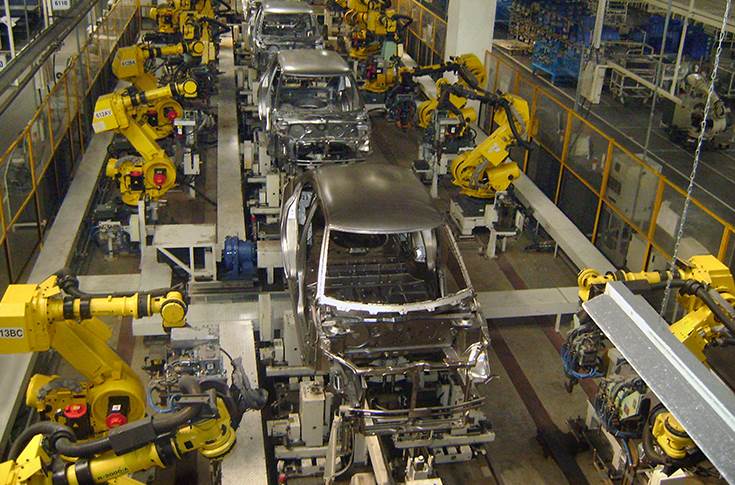 Takeuchi had told shareholders that the company got a confidence boost when India overtook Japan as the third-largest car market in 2022; it made Suzuki optimistic not only about India’s domestic market, but also its export potential.
Takeuchi had told shareholders that the company got a confidence boost when India overtook Japan as the third-largest car market in 2022; it made Suzuki optimistic not only about India’s domestic market, but also its export potential.
Apart from targeting a 50 percent domestic volumes growth to more than three million units by the end of the decade, it plans to almost triple its exports to 7,50,000 units by 2030. These plans need “huge capacity.”
Takeuchi had said it can be projected that by 2030, the automaker would need a production capacity of over four million, almost double the current capacity. “That is quite a challenging task,” as the company would need to construct two manufacturing facilities parallelly, each having an annual production capacity of one million units — a feat that has never been achieved before.
Construction work at the first site (Kharkhoda, Haryana) has started. The first plant with a capacity of 2,50,000 units will be operational in 2025. Three additional plants will be constructed in a phased manner to take the cumulative capacity to one million units eventually.
Hunt is on for a location for the second facility, which will add another one million units. Sources say the plant may come up in Gujarat.
“Such a large-scale capacity expansion, simultaneously at two locations, has never been done. I am counting on my people, business partners and our parent SMC, which in the past accomplished many tasks that appeared impossible at the beginning. We might have to keep thinking of the best possible ways to manage the scale and make sure that we continue to stay ahead. With expanding capacity, offering multiple Co2 reduction technologies and new products, we are writing a new chapter in the history of the company – Maruti Suzuki 3.0,” the CEO had told shareholders.
By the end of the decade, the product portfolio will expand from 17 to 28 models and six of those will be in the electric vehicle portfolio.
New structure with new vision
Given the magnitude of the work at hand, the management decided to merge its contract manufacturing arm Suzuki Motor Gujarat, with Maruti. The company’s board in November approved the issuance of equity shares on preferential allotment to Suzuki Motor Corporation (SMC), as consideration for the acquisition of a 100 percent stake by SMC in Suzuki Motor Gujarat Private Limited (SMG).
Given the rapidly evolving market dynamics, Maruti Suzuki will be able to cater to changing needs quickly through the new arrangement. “There are times, wherein we need to quickly ramp up or ramp down production of certain models based on market situation, those decisions can now be taken quickly. It will allow us to speed up the process once SMG becomes a part of the MSIL system,” the MD and CEO said.
The tectonic shifts require a change in structure to keep the operations smooth. As Bhargava had said earlier this year, “It would be rather sad if management is not able to adjust its strategy. Anybody who does not change with time runs the risk of being obsolete.”
The new arrangement will help in controlling production cost.
Takeuchi had said that the process would take time and lead to a significant evolution in operations. “At Suzuki Motor Gujarat, some of the management positions are held by experts from Japan, but gradually that will be replaced by Indian management.”
The move will also groom Indian talent to manage the transition towards zero-emission vehicles.
The merged entity will allow Maruti to take quick decisions and in a unified manner. While the functions of marketing, sales and supply chains will be the same, the production planning and schedules managed by the Japanese so far – will be managed by Indians executives.
Eyeing global frontiers
Another defining factor of this new vision is to almost triple exports to 7.5 lakh units by 2030. Toyota Motor will be a big contributor to this accelerated plan. Not only will Maruti Suzuki benefit from the global alliance of Suzuki and Toyota — that is set to witness a new phase of integrated product and technologies launch plan — but there will also be a bigger responsibility to add new geographies for exports from India.
Suzuki-Toyota will look at building market opportunities in Africa, Middle East and Latin America. Also, Made-in-India EVs may go to evolved markets of Europe and Japan, say sources.
This clearly underlines the growing role of India in the global scheme of things.
Technology agnostic road to reduced emissions
While there is strong support from the Government of India towards zero-emission technology, Maruti Suzuki is adopting a multi-powertrain strategy, given the infrastructure in the country. Takeuchi said for an automobile company, carbon emissions from products contribute nearly 80 percent of the total carbon emissions. Its reliance on multiple powertrain technologies will help reduce carbon footprint.
“Having multiple powertrain technologies removes excessive reliance on a single technology and de-risks decarbonisation achievements. Accordingly, the company is adopting CNG, flex fuel (Ethanol blending anywhere from 20 percent to 85 percent with petrol), hybrid-electric and electric vehicles. The share of models with CNG powertrain in our sales has been increasing and has exceeded an all-time high of 20 percent in FY23,” added Takeuchi.
Maruti Suzuki expects 25 percent of its sales to come from strong hybrids, 15 percent from battery electric vehicles and about 60 percent from the internal combustion engine like CNG, CBG, ethanol and flex fuel. This means the company is aiming to sell over 1.2 million electrified vehicles by FY31.
EVs part of Maruti future – but not the only future
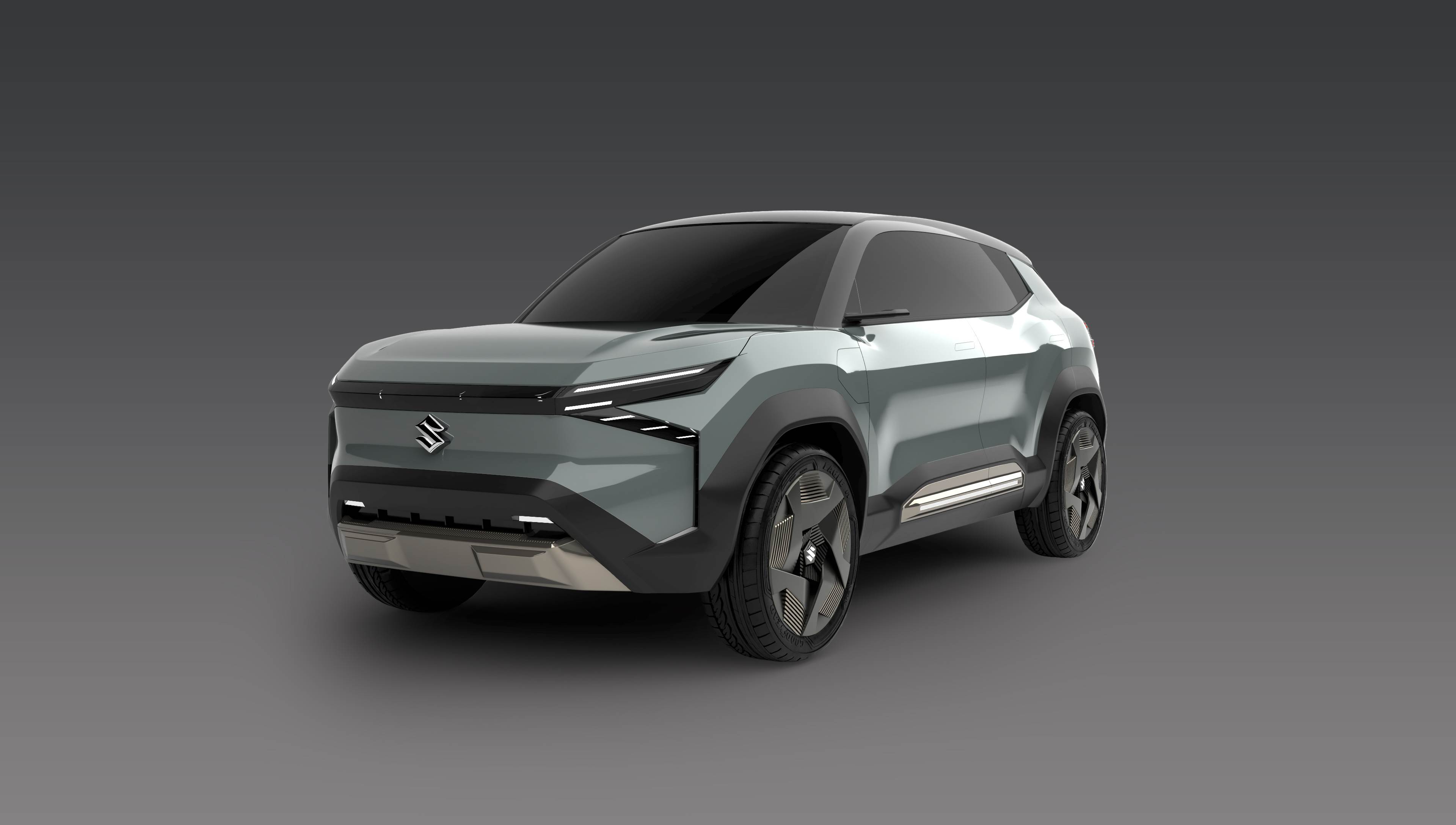 The parent Suzuki Motor Corporation is front-loading investment to ensure that the risks of the electric vehicle (EV) business does not slow down the market leader Maruti Suzuki India Limited.
The parent Suzuki Motor Corporation is front-loading investment to ensure that the risks of the electric vehicle (EV) business does not slow down the market leader Maruti Suzuki India Limited.
Suzuki Motor has committed Rs 10,440 crore for the electric vehicle business. The money will go into manufacturing and localisation of batteries.
“SMC has committed a huge investment, especially for decarbonisation efforts. This includes launching six EV models by 2030-31 in India. The company will be launching its first EV in FY 2024-25, based on the EV concept that was showcased at the AutoExpo held in January 2023. This is a mid-segment SUV with a range of 550 km and battery capacity of 60 KWh. The EV will be manufactured by
Suzuki Motor Gujarat, for which the production facility is being set up. For EV battery manufacturing, SMC is setting up a facility in Gujarat,” Takeuchi had informed shareholders earlier in the year.
The company has lined up a portfolio of half a dozen EVs and the first midsize SUV EV will come in Q1 of 2025. It may share the vehicle with Toyota Kirloskar in India and allocate 80 percent of the output for exports — which helps in building scale and reducing cost.
To be sure, Maruti Suzuki had rigorously tested the Wagon R electric vehicle but shelved the plans as the vehicle was too expensive. But with a strong localisation plan in place, Maruti Suzuki is now aiming to offer products at price points to cater to a wide addressable market.
Here, too, while the financial commitment is from SMC Japan, Indian engineers are likely to steer the EV project.
The company’s efforts are now focused on making systems, processes and facilities more flexible so that it can quickly change plans on the go.
Critics remain sceptical as Maruti Suzuki gave up on diesel very early and is late to the EV party. But the company’s top executives say they are on time as its EVs will hit the road by 2025, when the EV adoption may hit three to five percent. They point out that this is the level at which EVs saw acceptance in France and Germany.
The EV penetration is two percent now; Tata Motors has over 90 percent share in it. Come 2025, the mainstream market is likely to have close to a dozen models for the prospective buyers. Along with Maruti Suzuki, the likes of Hyundai, Kia, Volkswagen, Skoda, including the homegrown car maker Mahindra & Mahindra and Tata Motors will have a flurry of new launches between 2024 and 2025.
Maruti Suzuki says its late entry will give it time to address the pain areas of adoption — such as cost and infrastructure.
Raghunandhan NL of Nuvama Institutional Equities says Maruti will continue to maintain its strength in the non-SUV portfolio thanks to its deep reach and CNG portfolio. The new range of SUVs will help Maruti build its market share to 31 percent and PV market share can go back to 45 percent in the next few years.
“MSIL has garnered a dominant market share in new segments, despite being a late entrant. In segments such as premium hatchback, mid-size sedan, over 4m compact UV and MPV, MSIL has captured share from incumbents to become the market leader within a short period of time (mostly one or two years), owing to a successful marketing mix built around 4Ps – price, product, place and promotion.”
“We expect MSIL to do well in EVs that are being jointly developed with Toyota (expected to be launched in 2025),” says Raghunandhan.
Way ahead and challenges
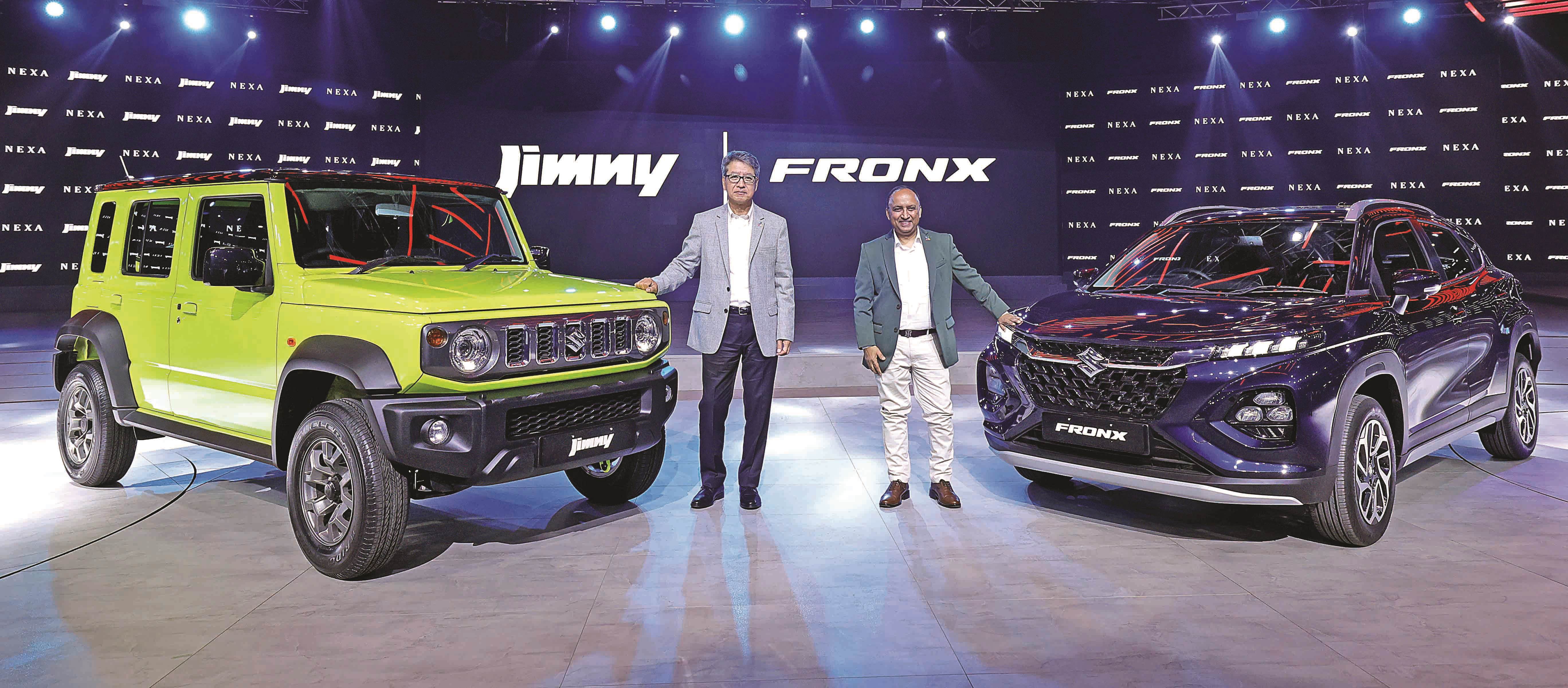 Hisashi Takeuchi with Shashank Srivastava, Senior Executive Officer, Sales and Marketing, Maruti Suzuki showcasing the new range of SUVs – Jimny and Fronx at the 2023 Auto Expo.
Hisashi Takeuchi with Shashank Srivastava, Senior Executive Officer, Sales and Marketing, Maruti Suzuki showcasing the new range of SUVs – Jimny and Fronx at the 2023 Auto Expo.
The momentum is on Maruti Suzuki’s side and the company is targeting a 10 percent growth in FY24 with the first full year of new SUV volumes (Fronx, Jimny and Grand Vitara) bringing in the incremental sales.
This is in a market that is likely to grow in the low single digit. So, it is almost certain that the company will gain share. Yet, reaching 50 percent market share in 2025 is going to be a tall ask.
For that, rivals will have to fall behind considerably. But Maruti may still close the year at a 44 percent market share.
Vangaal says there is no other brand that understands the Indian market better than Maruti Suzuki; but the impact of calibrated approach on safety and electrification remains to be seen.
“Given the fact that India is number 1 priority, it is not hard for Maruti Suzuki to catch up. Case in point is premiumisation and catching up with the SUV trend. The premise of design, safety and electrification are key customer trends that Indian car makers have capitalised on, wooing the young buyers of today. These are the areas Maruti Suzuki needs to accelerate to hold on to its 50 percent market share target,” says the associate director from S&P Global.
For Takeuchi, achieving 50 percent market share means reviving the small car segment, boosting SUV market share and building a multi-power train portfolio with high localisation.
The MD of Maruti Suzuki says he intends to fill the gaps in the SUV portfolio and spruce up both Arena and Nexa channels with more models. With the EVs coming, Maruti will have the widest portfolio in the country at 28 models in the mainstream market.
The small car challenge
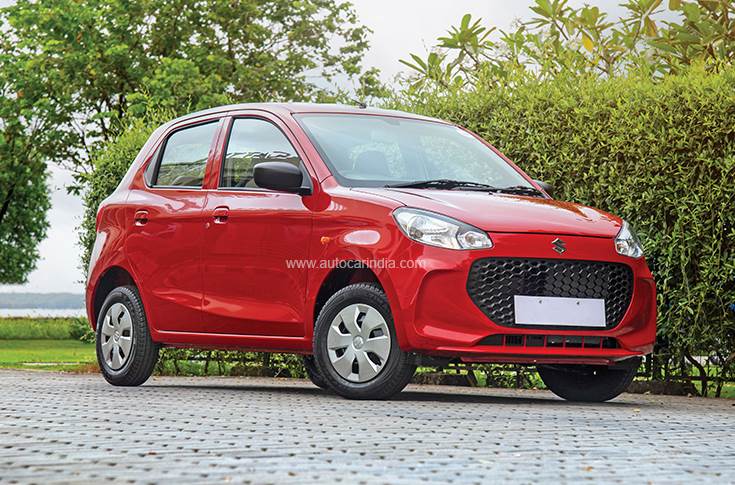 The biggest challenge for the company would be reviving its small car portfolio, experts say. This segment accounts for a third of its volumes. V G Ramakrishnan, MD and Managing Partner at Avanteum Advisors LLP, says protecting its share will be a “key requirement” for Maruti.
The biggest challenge for the company would be reviving its small car portfolio, experts say. This segment accounts for a third of its volumes. V G Ramakrishnan, MD and Managing Partner at Avanteum Advisors LLP, says protecting its share will be a “key requirement” for Maruti.
“Competitors are gaining rapidly in India. With prices of vehicles increasing across segments due to costs involved in meeting emission standards, the entry level market will shrink over a period of time, affecting the core market of Maruti Suzuki where it’s the undisputed leader. Competition is severe in the SUV space and with SUV increasing its shares in the total passenger vehicles market, there is a possibility of Maruti Suzuki ceding market share to competition,” adds Ramakrishnan.
The acquisition price of the entry level car has gone up by 20-25 percent but the income levels of the prospective buyers at the bottom end of the pyramid have not gone up as much. The chairman of the company said at a recent interaction that in this segment, only bread is left and there is no butter anymore to capitalise on.
Takeuchi is banking on the sustained economic growth of the last three years to lead to a better distribution of income, encouraging people to buy their first car.
He tells Autocar Professional that the company is not “giving up” on the small car; and in fact, in its eight-year plan, the hatchback will continue to account for over 27 percent of its total sales. Takeuchi says the company will continue to look at reducing cost as much as possible to improve accessibility of small cars. With the sustained improvement in incomes, buyers will eventually come back in 2024-25, as many had deferred their purchase since Covid-19.
Transition to CAFE
Ramakrishnan says that the Battery Electric Vehicle (BEV) is the Government of India’s preferred choice for low or zero emission vehicles. If Maruti Suzuki and Toyota Motors visualise that hybrids will be an intermediate stage on the path to BEV or even a possible leap from hybrids to hydrogen fuel cell technology which is zero emission, then it needs to shape the narrative around hybrids with policymakers. “Maruti Suzuki also believes given the type of vehicles, infrastructure evolution and income levels in India, hybrids offer a practical solution to rapidly decarbonise the personal transportation market. Shaping the GST on hybrids closer to 28 percent can help Maruti Suzuki in aligning its key market to the global vision of its partner firm Toyota capabilities,” adds Ramakrishnan.
To be sure, Toyota has already successfully used hydrogen FCVs during the Tokyo Olympics and sees that as the eventual solution to zero emissions despite considerable challenges in H2 infrastructure. And Toyota, along with Maruti, has attempted on several occasions to sensitise the government on the critical role of hybrids. Takeuchi says the company needs to do a lot more on the hybrid technology and will try to reduce the cost.
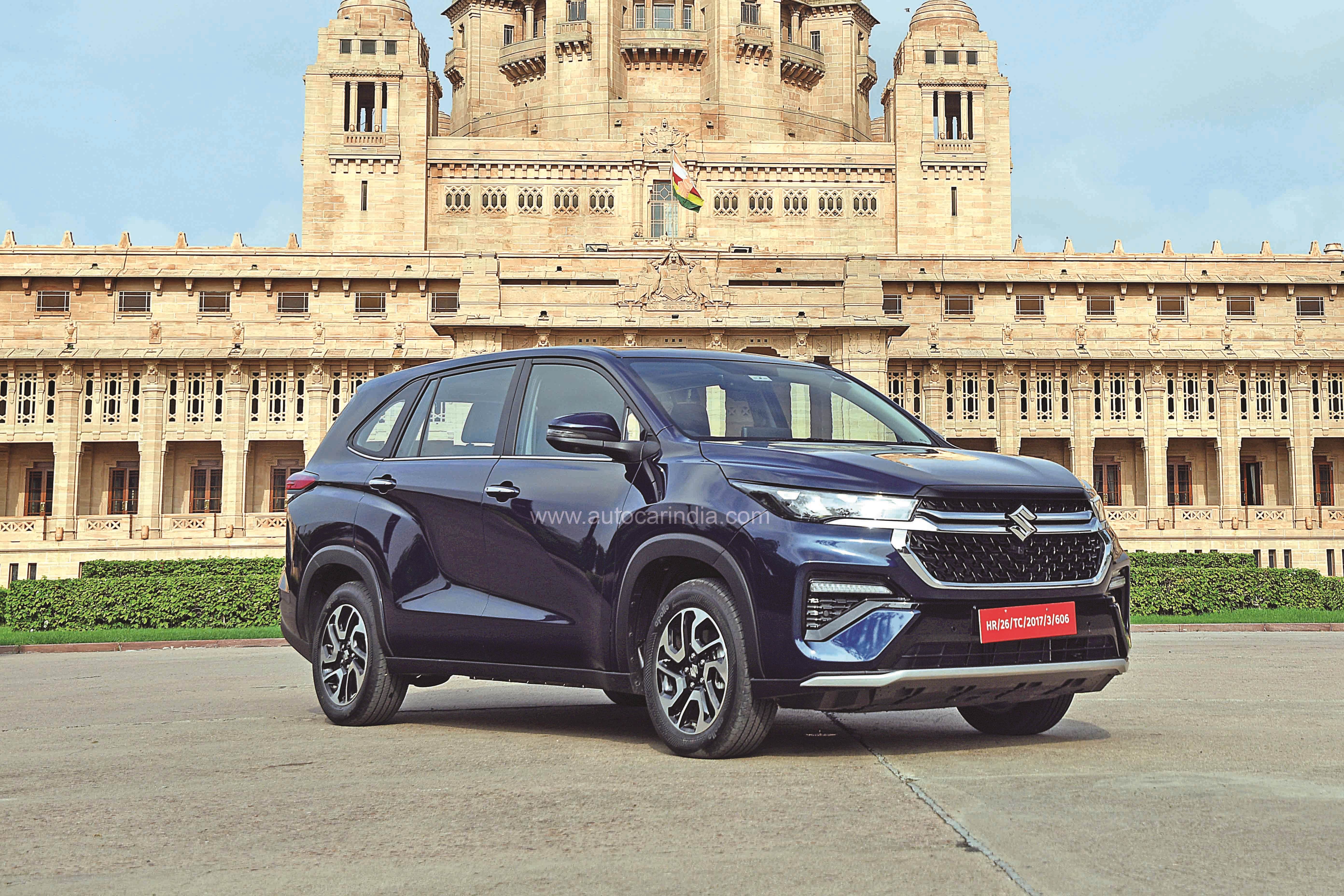 The hybrid variant accounts for a fifth of its sales in Grand Vitara and the premium MPV Invicto comes only with hybrid powertrain. At the end of the decade, the company expects hybrids to account for 25 percent of its total sales.
The hybrid variant accounts for a fifth of its sales in Grand Vitara and the premium MPV Invicto comes only with hybrid powertrain. At the end of the decade, the company expects hybrids to account for 25 percent of its total sales.
This may be possible only with mainstream compact cars. Takeuchi says the company may also look at hybrids for smaller vehicles to democratise the usage and reduce the cost. The overriding principle for Toshihiro Suzuki, the global CEO of Suzuki Motor Corporation is that the path towards carbon neutrality will be “defined by conditions in each country and region” and hence efforts needs to be made “by using the right materials in the right places to find the answer.” Maruti Suzuki is also working on developing the compressed biogas infrastructure in India; it sees this as a unique alternative in the country. The parent, Suzuki Motor Corporation has agreed to build four biogas refining plants in India with two local partners. The facilities will go onstream in 2025. The company has partnered with Banas Dairy and the government-affiliated National Dairy Development Board and will spend a little over Rs 230 crore on a project in Gujarat.
The drive ahead
Clearly, Takeuchi’s plate is full. As Bhargava says, a stronger Maruti is a strong Suzuki, and the headquarter is absolutely committed to the Indian market.
To add to that, the support from Toyota Motor Corporation for India means Maruti Suzuki won’t be left behind in case of any major technological disruption.
Takeuchi says with Maruti Suzuki 3.0, the company is writing a new chapter in history. He has delivered so far. But the road ahead is long and full of blind turns. No one can say what the next phase of disruption in mobility will be. Whatever it is, Takeuchi will have to steer Maruti through all the bends with a firm hand on the steering wheel.
This feature was first published in Autocar Professional’s December 15, 2023 issue.
